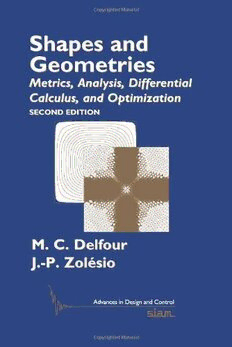
Shapes and geometries. Metrics, analysis, differential calculus PDF
646 Pages·2010·3.034 MB·English
Most books are stored in the elastic cloud where traffic is expensive. For this reason, we have a limit on daily download.
Preview Shapes and geometries. Metrics, analysis, differential calculus
Description:
This considerably enriched new edition provides a self-contained presentation of the mathematical foundations, constructions, and tools necessary for studying problems where the modeling, optimization, or control variable is the shape or the structure of a geometric object. Shapes and Geometries: Metrics, Analysis, Differential Calculus, and Optimization, Second Edition presents the latest ground-breaking theoretical foundation to shape optimization in a form that can be used by the engineering and scientific communities. It also clearly explains the state-of-the-art developments in a mathematical language that will attract mathematicians to open questions in this important field. A series of generic examples has been added to the introduction and special emphasis has been put on the construction of important metrics. Advanced engineers in various application areas use basic ideas of shape optimization, but often encounter difficulties due to the sophisticated mathematical foundations for the field. This new version of the book challenges these difficulties by showing how the mathematics community has made extraordinary progress in establishing a rational foundation for shape optimization. This area of research is very broad, rich, and fascinating from both theoretical and numerical standpoints. It is applicable in many different areas such as fluid mechanics, elasticity theory, modern theories of optimal design, free and moving boundary problems, shape and geometric identification, image processing, and design of endoprotheses in interventional cardiology. Audience: This book is intended for applied mathematicians and advanced engineers and scientists, but the book is also structured as an initiation to shape analysis and calculus techniques for a broader audience of mathematicians. Some chapters are self-contained and can be used as lecture notes for a minicourse. The material at the beginning of each chapter is accessible to a broad audience, while the subsequent sections may sometimes require more mathematical maturity. Contents: List of Figures; Preface; Chapter 1: Introduction: Examples, Background, and Perspectives; Chapter 2: Classical Descriptions of Geometries and Their Properties; Chapter 3: Courant Metrics on Images of a Set; Chapter 4: Transformations Generated by Velocities; Chapter 5: Metrics via Characteristic Functions; Chapter 6: Metrics via Distance Functions; Chapter 7: Metrics via Oriented Distance Functions; Chapter 8: Shape Continuity and Optimization; Chapter 9: Shape and Tangential Differential Calculuses; Chapter 10: Shape Gradients under a State Equation Constraint; Elements of Bibliography; Index of Notation; Index.
See more
The list of books you might like
Most books are stored in the elastic cloud where traffic is expensive. For this reason, we have a limit on daily download.
